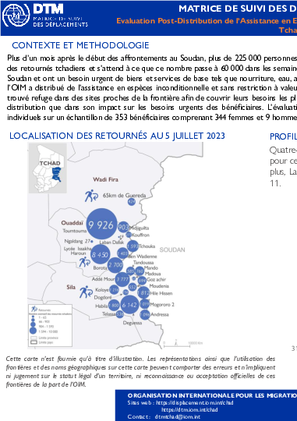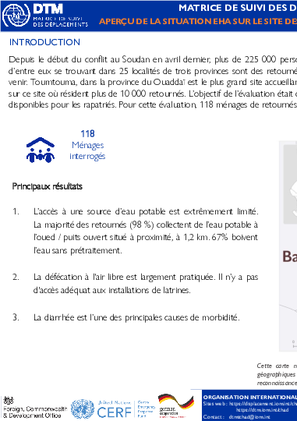Module 09 - Safely responding to incident disclosure
This training materials, were developed to provide enumerators background information on how to safely respond to incident disclosure
This training materials, were developed to provide enumerators background information on how to safely respond to incident disclosure
Intended return movements to places of origin from Balama and Ancuabe districts (sede) from July 3rd triggered 650 individual departures from Balama and Namuno Muidumbe (Chitunda and Miengueleua) district. An estimate of 116 Intended returning persons were identified with vulnerabilities. Within this reporting period, all of the recorded movements were displaced for the second time. Movements in the region continue to be dynamic between host and displaced communities. The objective of the Emergency Tracking Tool (ETT) - Movement Alert is to collect information on large and sudden population movements, and to provide support to the humanitarian response partners by disseminating data on IDPs to support effective humanitarian response to the affected population. Information is collected through key informants interviews or direct observation. This alert provides basic information on displacements, and additional information can be shared upon request.
IDPs
Returnee (Previously Displaced Abroad)
Returnee (Previously Internally Displaced)
Unit of Analysis Or Observation
Admin Area 2
Admin Area 3
Individual
Type of Survey or Assessment
Key Informant
Administrative boundaries with available data
The current dataset covers the following administrative boundaries
Unit of Analysis Or Observation
Type of Survey or Assessment
Administrative boundaries with available data
The current dataset covers the following administrative boundaries
Unit of Analysis Or Observation
Type of Survey or Assessment
Administrative boundaries with available data
The current dataset covers the following administrative boundaries

Plus d’un mois après le début des affrontements au Soudan, plus de 225 000 personnes ont traversé la frontière vers le Tchad. L’OIM estime que plus de 46, 000 d’entre eux sont des retournés tchadiens et s’attend à ce que ce nombre passe à 60 000 dans les semaines à venir. La plupart des retournés sont installés spontanément près de la frontière avec le Soudan et ont un besoin urgent de biens et services de base tels que nourriture, eau, assainissement et hygiène, abris, articles non alimentaires, santé et protection. En mai 2023, l’OIM a distribué de l’assistance en espèces inconditionnelle et sans restriction à valeur de 40 000 francs CFA (FCFA) par ménage à 2 879 ménages retournés vulnérables ayant trouvé refuge dans des sites proches de la frontière afin de couvrir leurs besoins les plus urgents. Cette étude évalue l’activité d’assistance en espèces, tant dans le déroulé de la distribution que dans son impact sur les besoins urgents des bénéficiaires. L’évaluation a été menée en juin 2023, environ un mois après la distribution, via des entretiens individuels sur un échantillon de 353 bénéficiaires comprenant 344 femmes et 9 hommes.

Suite au conflit armé survenu en avril 2023 au Soudan, des milliers de personnes ont été contraints de quitter ce pays pour se réfugier au Tchad, principalement à l’Est. Il est à noter que ces ressortissants tchadiens vivant au Soudan depuis des nombreuses années ont été enregistrés par l’OIM dans plusieurs sites dans les provinces du Sila et du Ouaddaï. En effet, l’OIM a organisé une enquête du 05 au 12 juin 2023 afin de recueillir les intentions de retour de ces derniers. De ce fait, 334 ménages ont été enquêtés dans la province du Ouaddaï et 36 ménages dans la province du Sila. Par ailleurs, la méthodologie consistait à prendre d’une manière aléatoire un échantillon des ménages de chaque site (soit 5% pour les sites dont le total des ménages est supérieur 750, 10% pour ceux dont le total des ménages est entre 750 et 250, et 20% pour ceux dont le total des ménages est inférieur à 250 ) et de procéder à l’entretien avec les chefs de ménages ou leurs représentants. En effet, 95 pour cent des répondants étaient des femmes et 5 pour cent des hommes. Ainsi, plus de la moitié des personnes enquêtées (56%) étaient âgées entre 26 et 45 ans et 23 pour cent entre 18 et 25 ans. Ce rapport présente les résultats clés de ces enquêtes dans les dix sites de deux provinces

Depuis le début du conflit au Soudan en avril dernier, plus de 225 000 personnes ont traversé la frontière vers le Tchad. L’OIM estime que plus de 46 700 d’entre eux se trouvant dans 25 localités de trois provinces sont des retournés tchadiens et s’attend à ce que ce nombre atteigne 60 000 dans les semaines à venir. Toumtouma, dans la province du Ouaddaï est le plus grand site accueillant des retournés tchadiens. Le 27 juin 2023, l’OIM a mené une évaluation rapide à sur ce site où résident plus de 10 000 retournés. L’objectif de l’évaluation était d’obtenir une vue d’ensemble des services d’Eau, Hygiène et Assainissement (EHA) disponibles pour les rapatriés. Pour cette évaluation, 118 ménages de retournés ont été sélectionnés aléatoirement et interrogés.

Depuis le début des affrontements au Soudan, plus de 225 000 personnes ont traversé la frontière vers le Tchad. L’OIM estime que plus de 46 700 parmi eux sont des retournés tchadiens et s’attend à ce que ce nombre passe à 60 000 dans les semaines à venir.
En coordination avec la CNARR et les organisations humanitaires, l’OIM a déjà enregistré 38 513 retournés et 75 ressortissants de pays (Soudan du Sud, Niger, Ethiopie, Republique Centrafricaine, Burkina Faso, Ouganda et Nigéria) dans 25 localités dans trois provinces. La plupart des retournés sont installés spontanément près de la frontière avec le Soudan et ont un besoin urgent de biens et services de base tels que nourriture, eau, assainissement et hygiène, abris, articles non alimentaires, santé et protection.
L’OIM a mené des évaluations post-distribution dans certains des endroits ciblés pour l’assistance humanitaire. 90 % des bénéficiaires enquêtés ont déclaré que l’assistance reçuee avait contribué de manière significative à répondre à leurs besoins. Tous ont encore des besoins non satisfaits, principalement 1) la nourriture (81%), les articles non alimentaires (79%), le logement (39%), la santé (27%). L’OIM travaille avec plusieurs partenaires opérationnels notamment le gouvernement du Tchad, le HCR, la LWF, PUI, l’UNICEF, MSF, le FNUAP, le PAM, IRC, la Croix Rouge du Tchad, le Comité internationale de la Croix-Rouge

Since the beginning of clashes in April in Sudan, over 225 000 people have crossed the border into Chad. IOM estimates that more than 46 700 of them are Chadian returnees and expects this number to rise to 60,000 in the coming weeks.
In coordination with CNARR and humanitarian officials, IOM has fixed and registered 38 713 returnees and observed 75 third-country nationals (from South Sudan, Niger, Ethiopia, the Central African Republic, Burkina Faso, Uganda and Nigeria) in 25 localities in three provinces. • Most of the returnees are currently residing in spontaneous locations near the border and are in urgent need of essential goods and services such as food, water, sanitation and hygiene, shelter, household items, health, and protection.
IOM conducted post-distribution monitoring exercises in some of the locations targeted for assistance. According to the results, 90% of the beneficiaries said the assistance contributed significantly to meeting their needs. All still have unmet needs after the assistance, mainly food (81%), NFIs (79%), shelter (39%), health (27%). IOM works with a range of operational partners in the returnee response including the Government of Chad, UNHCR, LWF, PUI, UNICEF, MSF, UNFPA, ICRC, IRC, the Chadian Red Cross and WFP